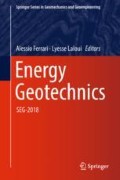Abstract
In recent years considerable effort has been directed to the study of stress-strain time effects on soil and soft rock, including; creep, stress relaxation, long term strength of soil and the effect of strain rate on shear strength. These aspects seem to be very important in design and construction of all underground structures. However, long term creep data from drained triaxial creep tests on undisturbed soil samples are very limited in literature. Most of published research work was concerned with the undrained behaviour. Five triaxial drained creep tests were carried out. In addition, three drained tests were used as control tests to determine the drained strength of the material. The applied constant creep stress level ranged from 30% to 80% of the failure stress. Four consolidated undrained triaxial creep tests were conducted at stress level of 30% to 90%. It has been found that the chalk marl is characterised with time-dependent deformations which cannot be accounted for by the anisotropic elastic model. Any constitutive relationship which realistically describes the deformation behaviour of the material must, therefore, include the time factor. Time-dependent deformations of chalk marl in drained and undrained triaxial states of stress will be discussed. For undrained triaxial creep tests, the response of pore pressure during a creep period is also presented. From this study, it can be mentioned that, for triaxial drained creep tests, the axial strain after 100 days of sustained stress ranged from 0.94% to 2.22% for stress levels ranging from 30% to 80%. For a creep period of 200 days, the axial strain ranged from 1.0% to 2.43% for stress levels of 30% and 80% respectively. The proportional increase of axial strain ranged from 24% to 41% at different stress levels. For undrained creep tests, the axial strain ranged from 0.45% to 2.16% for stress levels of 30% to 90%. It can be concluded from this study that time-dependent deformations (creep) of chalk marl constitute a large percentage of the total deformation. It must be taken into consideration in the design of important projects, such as hydro power plants tunnels, nuclear reactor foundations, and underground metro stations.
Access this chapter
Tax calculation will be finalised at checkout
Purchases are for personal use only
References
Al-Mohamadi, N.M.: Strength and deformation characteristics of Chalk Marl from the channel tunnel. Ph.D. thesis University of Surrey, UK (1976). (unpublished)
Al-Mohamadi, N.M.: Creep characteristics of Chalk Marl under uniaxial and confined compression state of stress. In: The Ninth International Structural Engineering and Construction Conference (ISEC-9) Valencia Spain (2017)
Bishop, A.W., Lovenbury, H.T.: Creep characteristics of two undisturbed clays. In: Proceedings of the 7th International Conference on Soil Mechanics and Foundation Engineering, Mexico City, vol. 1, pp. 29–37 (1969)
Davies, R.: Creep characteristics of three undisturbed clays. Ph.D. thesis, University of London (1975)
Lacasse, S., Berre, T.: Undrained creep susceptibility of clays. In: Proceedings of the 16th International Conference on Soil Mechanics and Geotechnical Engineering. Milli Press Science Publishers (2005–2006)
Mitchell, J.K.: Shearing resistance of soils as a rate process. J. SMFD ASCE 90(SM1), 29 (1964)
Murayama, S., Shibata T.: Flow and stress relaxation of clays. In: Proceedings of IUTAM Symposium on Rheology and Soil Mechanics, Grenoble, pp. 99–129 (1964)
Wang, Y.F., Zhou, Z.G., Yin Cai, Z.: Studies about creep characteristics of silty clay in triaxial drained creep tests. Appl. Mech. Mater. 580, 355–358 (2014)
Acknowledgment
The author would like to show his appreciation to the Applied Science University for their financial support of this work.
Author information
Authors and Affiliations
Corresponding author
Editor information
Editors and Affiliations
Rights and permissions
Copyright information
© 2019 Springer Nature Switzerland AG
About this paper
Cite this paper
Al-Mohamadi, N. (2019). Time-Dependent Deformation of Chalk Marl Under a Triaxial State of Stress. In: Ferrari, A., Laloui, L. (eds) Energy Geotechnics. SEG 2018. Springer Series in Geomechanics and Geoengineering. Springer, Cham. https://doi.org/10.1007/978-3-319-99670-7_39
Download citation
DOI: https://doi.org/10.1007/978-3-319-99670-7_39
Published:
Publisher Name: Springer, Cham
Print ISBN: 978-3-319-99669-1
Online ISBN: 978-3-319-99670-7
eBook Packages: EngineeringEngineering (R0)

